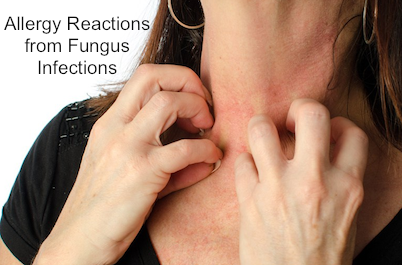Allergy from Fungus Infections
THIS TYPE of allergy not infrequently follows an infection with one of the various fungi on the skin, and is due to the reaction of the fungi and the resulting substances entering the blood stream. The person with athlete’s foot or ringworm of the scalp which may have persisted for many years may suddenly develop a rash elsewhere on the body. This may be similar to the focus of infection in a tooth with a resulting pain in a joint such as the shoulder or knee. The allergy has become apparent after the initial focus has been present for a period of time, producing the skin rash only after a new infection occurs. This has been proved scientifically and the conditions have been called by the original name with “id” added to it (trycophytid, epidermophytid and so forth).
This condition frequently is due to neglect of the primary fungus infection or due to incorrect or too vigorous treatment, with resultant irritation. The use of strong local medication, or even X-ray treatment, added to the friction and maceration from strong soaps will cause this allergy. This can be demonstrated by a skin test to the fungus involved; it is usually very accurate. The hands and feet are most commonly involved in both the primary infection and the “id.”
To establish the diagnosis is a relatively easy matter. This can be done by taking scrapings from the skin and examining them under the microscope. The hairs, scales of the skin, scrapings from nails and small skin blisters will usually, on examination, reveal the nature of the fungus involved in the primary disease. If any question remains, a culture of the material will reveal the culprit.
The treatment is good today. It was not always so, but, in recent years, the discovery of oral antifungus medication has made a difference. This, however, will not do the job alone; recurrence will result if the primary focus in the skin is not properly treated. All clothing, especially socks and shoes, must be adequately disinfected. In some cases, it may still be necessary to give allergic treatment in addition to the above, if one of the allergic skin conditions, such as contact dermatitis or atopic dermatitis, is present.
In order to round out this matter of contact irritants, we cannot overlook the molds as a source of sensitivity.
It would be simple, but useless, for us to spring upon the reader such names as Cephalosporium or Trichophyton cerebriform, and no doubt we’d have you worried. It is much less academic to explain that molds are those fuzzy growths that grow on bread, on the backs of books or, in fact, just about anywhere that bacteria do not grow. They require very little nourishment, but considerable dampness.
You can be certain that, wherever you are, the air and ground about you are saturated with many of the 265 kinds of mold spores known by scientists. If it will clarify this statement, we would like to say further that one tiny gram of soil has been found to contain 129,000 such fungus spores.
Molds are the basis of such foods as cheese and yeast. Individuals found to be sensitive to such foods are merely reacting to the molds contained in them.
The thing to be remembered is that each mold spore is a living organism, and that anything living, whether it be a mother-in-law or a piece of yeast, is apt to cause an irritation if the right conditions exist.
You may have heard your doctor say that a bad tooth is a focus of infection. He simply means that, whatever your trouble is—arthritis, asthma or any other altered reaction— it originates in the bacterial or fungus infection around that bad tooth. Your difficulty could also have its origin in the tonsils, sinuses, bowels or genital area, for these are common foci of infection of bacteria or fungi. Written By: Jack A. Rudolph, M.D. & Burton M. Rudolph. M.D., Continue Reading: Allergy of the Eyes

No Comments